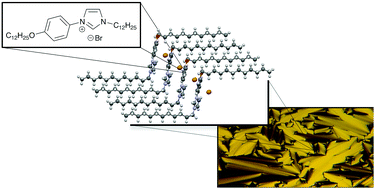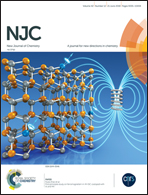Heterogeneous microwave-assisted Ullmann type methodology for synthesis of rigid-core ionic liquid crystals†
Abstract
We present an efficient Ullmann-type synthesis methodology enabling the preparation of imidazolium compounds with an extended aromatic core in three steps. This procedure begins with a microwave-assisted, heterogeneously catalysed cross-coupling reaction in the presence of Cu(II)-doped NaY zeolite to obtain imidazole-aromatic derivatives directly in good yield. The innovation is that this reaction does not require solvent, ligand or an inert atmosphere. Subsequently, these derivatives have been alkylated with bromoalkanes and the bromide of the imidazolium products exchanged for [BF4]− or [PF6]− anions. We have studied the influence of the methyl group (inductive effect) on the aromatic unit during the coupling reaction as well as its impact on different arrangements in the crystalline state. We have been able to extend this synthesis to ionic liquid crystal compounds which display lamellar self-organization (smectic A). The mesomorphic behavior and phase transition temperatures were investigated by polarizing optical microscopy (POM), differential scanning calorimetry (DSC) and small-angle X-ray scattering (SAXS).



 Please wait while we load your content...
Please wait while we load your content...